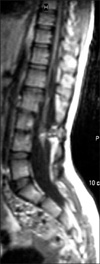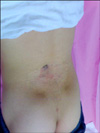Abstract
Faun-tail presents as an abnormal lumbosacral hypertrischosis and may be associated with spinal dysrasphism. In addition to the problems due to spinal anomalies, patient's physico-social life may also be affected. Here, we report a case of 13 years old female patient with Faun-tail in association with sypinal dysraphism, in which cosmetic improvement was achieved with the help of Alexandrite laser. Alexandrite laser can be the method of choice for permanent hair removal method due to its safe, effective and easy to apply properties.
Faun-tail nevus is a rare reported entity which is clinically presented as an abnormal lumbosacral hypertrichosis with spinal dysraphism. A proper evaluation with neurological and radiological examinations, may prevent possible sequels associated with spinal dysraphism1-4. In addition to the problems associated with spinal anomalies such as, back pain or incontinence, patient's physico-social life may be affected because of the localised hypertrichosis. This localised hypertrichosis can be managed with the help of different hair removal techniques5,6. In our present study, we report a case of 13 years old female patient with Faun-tail nevus in association with spinal dysraphism, in which cosmetic improvement was achieved with the help of Alexandrite laser. Alexandrite laser can be the method of choice for permanent hair removal method due to its safe, effective and easy to apply properties.
A 13 years old female patient was admitted to the hospital due to presence of an excessive amount of hair on her lower back which was present since her birth. She neither had a subjective complaint nor a history of urinary incontinence on her medical history. Family history and pedigree analysis revealed no related abnormalities. She declared that her physcology and private life were affected because of this condition. On examination, a 10×15 cm localised hypertrichotic patch with dark, hard hairs on the lumbosacral region was observed (Fig. 1). Because of possible spinal abnormalities, she underwent neurological and radiological examinations. Neurological examination was found to be normal. She never complained about any urinary incontinence. Her urodynamic test was also normal. Magnetic resonance imaging revealed spinal dysraphism and an intradural fatty density lesion resembling a lipoma at the lumbar 3 and 4 level. Terminal syrinx was also seen at level L-1 (Fig. 2). Because the natural course of asymptomatic spinal dysraphism was not known with certainty, this incidental and asymptomatic case was not operated on. Patient will be closely followed-up for few years through neurosurgery. Only hair removal for the sake of physcological and cosmetic improvement was advised and the procedure was planned by dermatology department. For permanent hair removal, a 755 nm Alexandrite laser was used. Initially, the long hairs were shortened by shaving and then laser energy with the help of 10 mm beam diameter at an intensity of 20 J/cm2 with pulse duration of 12 msec was used. The treatments were given in the form of seven sessions after every 4 or 5 weeks. During the follow up after 11 months, minor re-growth of some thin and light hairs was observed, but treatment was not continued as the patient was satisfied with the results (Fig. 3).
Hypertrichosis is the condition associated with abnormal hair growth and should be differentiated from hirsutism that is related with hormonal changes. Congenital hypertrichosis is present at birth and may be in the generalised or localised forms. Congenital localised hypertrichosis localizing in lumbosacral area with dark and coarse hairs is called as Faun-tail nevus and may be associated with occult spinal defects. Patients should be e carefully valuated radiologically and neurosurgically for the diagnosis of possible associated defects. The most common spinal defect is spinal dysraphism, and may manifest as spina bifida, diastometamyelia, tethered cord, intraspinal lipomas, dermal sinuses, lipomeningomyeloceles, cutaneous aplasia and hemangiomas1.
Faun tail is a rare reported entity. In the literature search there are no large series of studies related to such a condition. The data is available only in the form of case reports. All these reports emphasized on the association of Faun-tail naevus and spinal anomalies because a delay in the diagnosis might result in serious irreversible neurological defects. It is also emphasised that dermatologists may be the first physician to witness the Faun-tail nevus, so they should be aware of the possible associated anomalies and consultate the patient with neurosurgeons. Such a consultation will help not only help in drawing a correct diagnosis, but as well for prescribing best treatments for both neurologic and cosmetic improvement. In most of the papers, surgical treatment for spinal anomalies has been mentioned and an advice of "laser treatment" for cosmetic improvement has been implicated. There are very few reports about the hair removal method for such cases. Mahendran reported a series of 7 patients with lumbosacral hypertrichosis with no evidence of spina bifida occulta whohave been treated with normal-mode Ruby laser5. In a report by Ramadasan et Patra, satisfactory results with electroepilation was achieved6. Very recently two cases of Faun Tail naevi in which a good cosmetic results were achieved by intense pulse light treatment were reported7,8.
As localised lumbosacral hypertrichosis with dark and coarse hair can cause significant cosmetic and psychological distress, removal of unwanted hairs might become necessary. The current available treatment methods for hair removal include bleaching, shaving, waxing, physical and chemical depilatories, electrolysis, intense pulsed light and laser hair removal. Considering the possible associated anomalies such as hemangiomas, lipomas; hair removal technique must be non-traumatising and preferably permanent. Electrolysis may be difficult when a large area is affected and may cause infections. Surgical removal of the patch may cause significant scarring. Traditional waxing, bleaching, shaving and depilatories are all temporary solutions and may traumatise the underlying lesions. Recently, laser hair removal has emerged as an effective, easy to use and safe method for achieving permanent results. Lasers, which are most frequently used in hair removal include ruby, diode, Nd:Yag, and Alexandrite. The principle of this therapy is the selective absorption of laser energy by melanin pigment in the hair follicle, which leads to its thermal destruction. Also, there is minimal absorption of energy by the surrounding tissues and thus skin damage is avoided. The light energy from the laser is transferred into thermal energy in the hair follicle. The laser targets melanin, or the pigmented regions of the follicle. The resulting thermal damage can lead to denaturization or irreversible coagulation of proteins, which leads to permanent destruction. Alexandrite laser with a wavelength of 755 nm, penetrates deeper into the hair follicles and remains less absorbed by epidermis when compared to other lasers9,10. Although the treatment choice depends on the degree and darkness of hypertrichosis, patients with light skin colour and dark hair seems to be the most suitable cases for Alexandrite laser epilation, as was the case in our patient.
Figures and Tables
References
1. Birol A, Bademci G. Faun tail: diagnosis of occult spinal dysraphism with a rare cutaneous marker. J Dermatol. 2004. 31:251–252.

2. Kaya TI, Kokturk A, Guleryuz A, Bagdatoglu C, Ikizoglu G. Faun tail: a rare cutaneous stigma of spinal dysraphism. Int J Dermatol. 2002. 41:119–120.

3. Antony FC, Holden CA. Diffuse hypertrichosis and faun-tail naevus as cutaneous markers of spinal dysraphism. Clin Exp Dermatol. 2002. 27:645–648.

4. Calikoğlu E, Oztaş P, Yavuzer Anadolu R, Catal F, Görpelioğlu C. Faun tail with aplasia cutis congenita and diastematomyelia. Dermatology. 2004. 209:333–334.

5. Mahendran R, Sheehan-Dare RA. Lumbosacral hypertrichosis treated with the normal-mode ruby laser. Acta Derm Venereol. 2003. 83:142–143.

7. Lee HI, Rho YK, Kim BJ, Kim MN. A case of faun tail naevus treated by intense pulsed light. Ann Dermatol. 2009. 21:147–149.

8. Ozdemir M, Balevi A, Engin B, Güney F, Tol H. Treatment of faun-tail naevus with intense pulsed light. Photomed Laser Surg. 2010. 28:435–438.





 PDF
PDF Citation
Citation Print
Print





 XML Download
XML Download